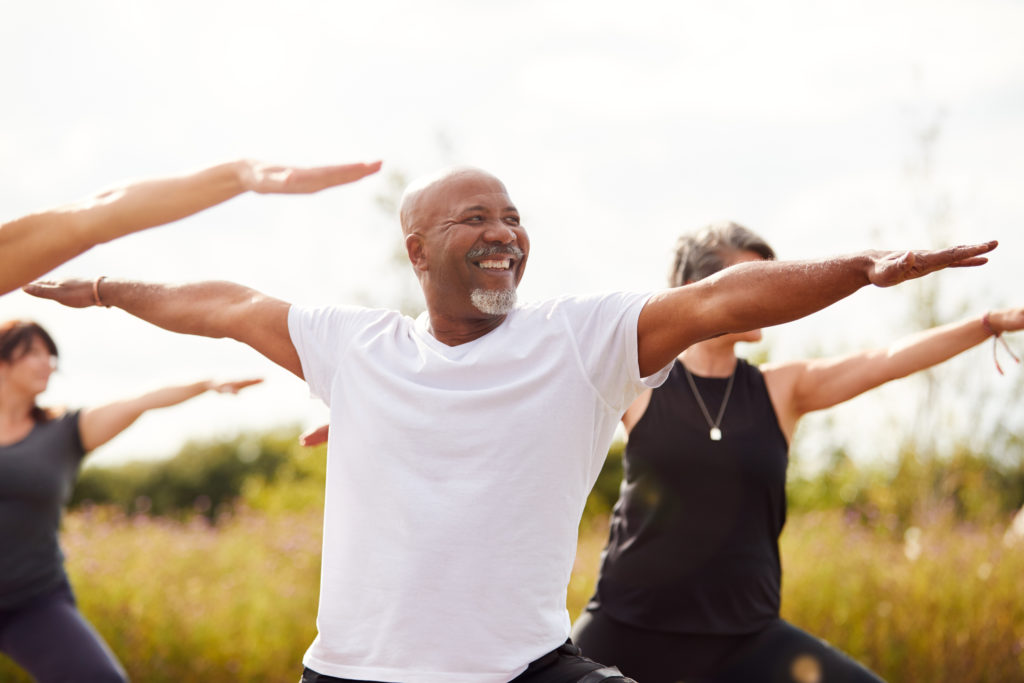Men’s Health: New Ways to Rev Up Your Fitness Routine

As restrictions on social distancing begin to ease, many senior men may have a hard time pulling themselves away from watching sports highlights and re-runs on TV. And, let’s face it, as we get older, it’s easy to wonder, “Why bother?”
Well, guys, there are a lot of good reasons for shedding that couch potato persona—from disrupting the connection between type 2 diabetes and cardiovascular disease, lowering your risk for obesity, high cholesterol. Along with shortening your life, they are major contributors to other conditions, such as blood clots or erectile dysfunction. While you are considering what size crowbar you need to pry you off the sofa and get back in the game, consider a new take on getting fit, such as:
Yoga: For many years, the benefits of yoga were supported largely by anecdotal evidence. Medical researchers today are now investigating the science behind yoga. They are trying to determine how yoga affects the body, whether certain health conditions might be improved by the practice…and whether yoga is a good therapy to integrate into traditional healthcare that promotes healthy aging.
Dr. Raj Rao of the American Academy of Orthopaedic Surgeons (AAOS) observed, “A good yoga program—that slowly progresses to more difficult poses and more strenuous activity—can lower a person’s heart rate, improve muscle and joint conditioning, decrease pain, and contribute to an overall sense of physical and mental well-being.” But Rao cautions, “If not done properly, or if someone embarks on a strenuous yoga program without guidance, it can cause serious pain or discomfort, and even injury.”
- Work with a qualified yoga instructor. Ask about his or her experience and credentials. If you choose to use a yoga DVD at home, look for one that comes highly recommended by your physician or other reliable sources.
- Warm-up thoroughly before a yoga session. Cold muscles, tendons and ligaments are vulnerable to injury. Make sure you cool down as well to relax your muscles and restore your resting heart rate and breathing rhythm.
- Listen to your body. If you experience pain or exhaustion while participating in yoga, stop or take a break. If pain persists, speak with your physician.
- Discuss any known illness or injury with your yoga instructor prior to the class so that he or she can recommend pose modifications.
- If you have an underlying joint or spinal injury or arthritis, gentle stretching helps avoid stiffness. Remember, however, that just as in all other activity, flare-ups of pain or injury may occur with yoga if tissues are stretched or stressed too quickly and beyond their physiologic level.
Chair exercise: Many studies confirm that older adults, even those who are frail and disabled, benefit in many ways by regularly using the muscles and stretching the ligaments. Appropriate exercise programs are available through senior centers and community fitness facilities but even right in the home, it’s possible to stretch and work all the important muscle groups and joints of the body, without any expensive equipment.
A sample beginning routine includes exercises that start from the head and neck and end at the feet and toes. You can do them while watching TV, or put on some nice music.
Resistance band training: Building strength is extremely helpful to maintain our balance as we age. Men typically consider this an activity done by lifting weights at a gym. Yet, if you want a way to help tone muscles that is affordable, offers a range of muscle-building options and takes nearly no space, consider resistance bands. Exercise physiologists have long understood the value of resistance band training because these bands offer what is called accommodating resistance. This means the farther that you pull a resistance band, the more it resists you. It is this tension that builds strength.
Research over the past 20 years has shown conclusively that regular physical activity, including strength training, stretching, and aerobic exercise, is an important contributor to healthy aging. Exercise can prevent or control many medical problems, reduce pain, improve sleep quality, help protect against falls, and promote a feeling of well-being. Try these activities as a new take on your old physical fitness regimes. No matter their level of fitness, every man can start now and reap the benefits of an individualized exercise program.
For More Information
Watch this video from the National Center for Complementary and Alternative Medicine (NCCAM) that looks at scientific studies focused on yoga’s effects o wellbeing.
Source: IlluminAge
The information in this article is not intended to replace the advice of your healthcare provider. Speak to your doctor or nutritionist before beginning an exercise regime.
![CPT Rehab [logo]](https://www.cptrehab.com/wp-content/themes/cpt-rehab/images/logo.png)